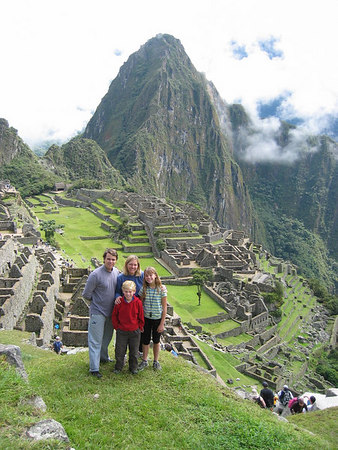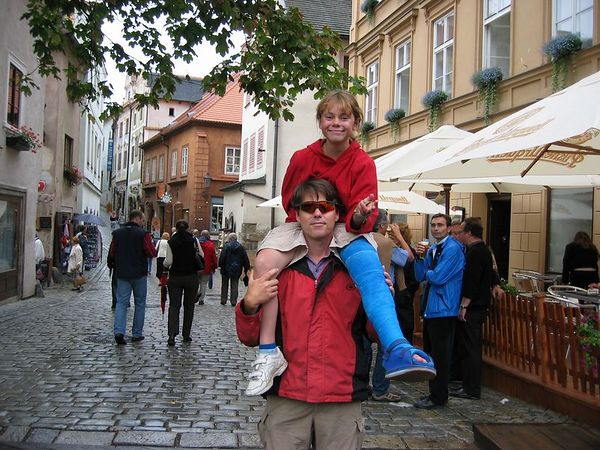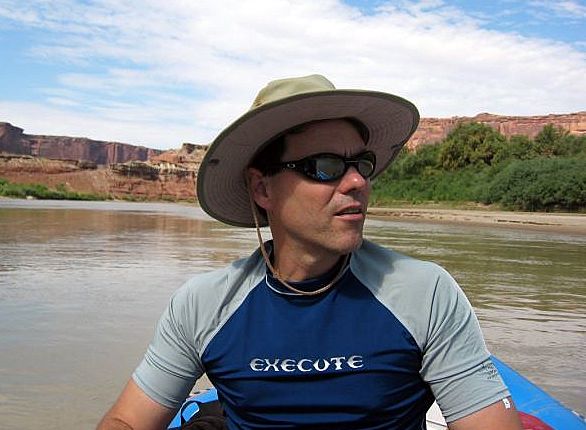Could you pack up your life and travel around the world with your kids for a year? Would you want to? For most of us, a year of traveling with family sounds like a pipe dream or a disaster waiting to happen. But for John Higham, author of 360 Degrees Longitude: One Family’s Journey Around the World, that’s just what he did. We talked with him about social-media savvy Masai warriors, his experience as an American in the Middle East, and his unquenchable desire for scuba diving.
1. Why did you and your wife decide to leave your tech jobs to travel the world with your kids for a year?
Before our kids were born we lived in Japan for a year. I had been sent by my company to babysit a satellite. We loved the experience of navigating a foreign country and culture, and we wanted to share that experience with our children when we had them.
The problem was, we couldn’t choose just one place that we would want to live for a year. So we thought, OK, we’ll choose four places and spend three months in each place. But we couldn’t settle on just four places, and so the idea quickly morphed into a trip around the world. As soon as we returned from Japan we started saving money with this goal in mind. Our first child was born as soon as we returned from our year in Japan, and our second child arrived three years later. Our two children grew up hearing us talk about and plan this grand adventure since before they could talk.
We lived our lives a bit more simply than we could have — we never bought the bigger house, and never bought the nicer car. As soon as our kids were old enough and we had saved enough money, we left!
-
What do you think your kids would have missed out on most if they grew up in the Silicon Valley bubble without ever taking this trip?
There are two things that we feel were important takeaways from spending a year traveling around the world with our children. The first is an understanding of our phenomenally privileged position on this planet. Our children commented after they came home that their peers seemed awfully concerned about acquiring the next popular video game, or buying a particular brand of designer jeans. During the months right after we returned there was an uproar in our community because the local school board wanted to redraw the school boundaries within the school district, and our neighborhood was going to have to move from one highly-rated school to another highly-rated school. Parents were bringing their children to school board meetings and having their children recite passionate testimonials about how devastating it would have to be to change schools. Our children were utterly mystified about all the hoopla. Our daughter commented at one point, “Why do these people think it even matters? Some children go to schools made of mud.”
The second takeaway we feel is most important is that we were able to spend 12 months of concentrated time together as a family. We certainly spent time together as a family before we took the trip, but so much of our family time was consumed by well-meaning people and well-meaning organizations, that our quality time together was limited. Well-meaning volunteers at our elementary school scheduled school walkathons and Halloween carnivals and junior olympics and all manner of activities that were worthwhile, but took time away from the family. Sports teams demanded long hours for practices and games. Our children’s friends’ birthday parties often prevented us from scheduling family outings on Saturdays. We found that the older our children got, the less control we had over our family time. Traveling together for a year allowed us to spend quality time together with no distractions. Our children became close to each other in a way that would not have happened had we not had that year together. That they have remained close friends in the years that have followed supports this.
-
How hard was it for you to unplug from the Internet/your devices? What was most surprising to you?
My family was very patient with me the first few months of the trip whenever I needed an internet fix. I was so accustomed to checking the news several times a day and answering emails as they came in, that initially I tried to maintain my same level of connectivity. I was constantly taking “internet walks” — I would walk slowly down a street trying to find an unsecure Wi-Fi connection. If I saw a sign advertising “free Wi-Fi” I would traipse all the way across town to find it. Personal hot-spots had not yet been invented (can you imagine?) and I would go to any length to get connected. My wife would roll her eyes and sigh, but was resigned to putting up with my addiction. My kids were oblivious to their lack of connectivity — they were 8 and 11 when we left on the trip and hadn’t yet developed the desire to stay constantly plugged in.
As we continued on our trip internet access actually got easier. We discovered that, believe it or not, the more affluent a country was, the harder it was for a traveler to get internet access. We started our trip in Europe, where most private homes had internet access, and most Wi-Fi networks were secure. There were very few internet cafes because the majority of the population had internet access at home. As the months went on, we found ourselves in poorer countries, where the general population relied on internet cafes for access. In countries with a very low per-capita income, say, Tanzania or Cambodia, internet cafes are everywhere. A local entrepreneur can start one of these businesses with very low capital — maybe a couple of computers and a router in the corner of their neighbor’s store — and travelers benefit tremendously.
But by the time we arrived in some of these developing countries, I had largely learned to live without constant connectivity. On average, I checked email maybe 3 out of 7 days a week — a huge reduction in frequency compared to when I had started.
Upon returning from our trip I tried to keep my data dependence habit in the closet, so to speak. But I do enjoy instant access to information. There is an undeniable thrill to be having a conversation with the family about, say, volcanoes, and be able to speak into my smartphone, “When was Mt. Vesuvius’ last eruption?” So, I kinda failed that 12-step program.
-
Why did you feel the need to stay connected (with world news, etc.)?
After 9/11 I had a morbid fascination with the news that persisted for years; until a certain point during our around-the-world-trip, in fact.
There were two factors driving this. The first is that we were constantly moving from area to area and country to country, and there was a preconception that Americans aren’t always… welcomed everywhere in the world.
My well-meaning mother kept my inbox full of alarming stories about the places we were soon to visit, for example. I’m now embarrassed to confess my initial anxiety about traveling in the Middle East. The people we’ve met in places like Turkey, Dubai, Egypt, and Jordan have been hands-down the most friendly, helpful, hospitable and gracious hosts. Reading the news actually increased my fear of traveling, while experiencing people and cultures on the ground made me realize that Western media skews and sensationalizes the truth, and plays to people’s fears.
The second reason I wanted to stay connected was simply that I wanted to keep up with the news of my large extended family and share my experiences traveling with friends and family. I sent emails every week or so to an ever-growing list of people, and it was the feedback from many individuals that finally convinced me to write a book.
-
At what point did you feel that it was ok not to constantly be plugged in? Was there a moment when you decided to let go? How did it feel?
Yes. It was wonderfully liberating.
Throughout the entire 12-month journey I loved trips to the internet cafe, but I ultimately let go of the dependency. One of my favorite memories is of walking into an internet cafe in a small town in Tanzania, and seeing a Masai warrior, dressed in a long robe, with his traditional spear leaning against a desk, checking his email. Or seeing a group of primary-school boys in a village in Bolivia, just after school was out for the day, running to an internet cafe to play a computer game together. We humans are so much more alike than we are different!
Yet there was a specific point when I finally understood the futility of trying to perceive the world as it was covered by mass-media news outlets. It went something like this (excerpt from book):
During our travels, September and the kids loved to tease me for my obsessive searching for open wifi networks so I could scan the headlines. It had been my way to keep my finger on the pulse of the world. Over the last dozen or so weeks, however, it was becoming increasingly clear that the world as viewed through the lens of the media was a different one from the world I was experiencing through our travels.
It isn’t as though I completely gave up going online for an information fix, but my compulsive behavior of searching for open wifi networks to satiate my morbid fascination with the post 9/11 news died in a food court in San Jose, Costa Rica.
I stuffed my e.brain back into my pocket, and turning to my family said, “I love being in a new place and discovering what makes it tick!”
That epiphany has not diminished since returning to Silicon Valley.
-
What was the biggest challenge you had with re-entering life in Silicon Valley (and the tech world) after your trip?
Before I left on the round-the-world trip with my family, I would find myself explaining what I did for work to people, and they would say with some amount of awe, “Wow…aerospace. Satellites. Rockets. That must be so cool!” It WAS cool, and it still is. But I see my career with a slightly different perspective now. I design and build satellites for commercial applications, like TV and radio. So I spend long hours in an office or conference room, in a building, in a technology park, making sure that Timmy gets his MTV. I must force myself not to drift off during long meetings to mentally revisit places I’ve been and reacquaint myself with the people I’ve met.
And then I have to remind myself that right now, I’m exactly where I need to be. I do actually need to earn a living, and I have a responsibility to my children to provide them with a stable home and a good education. After the children are grown and educated and our responsibilities in this area are met, my wife and I plan to get right back out into the developing world and figure out how we can make an impact. I hope we can put our career experience with technology to good use in some kind of meaningful humanitarian endeavor — I believe that technology can be a huge force for good in the world.
-
When you returned to your plugged-in life, did you notice a difference in your habits or your views of Silicon Valley and technology as a result of the your trip?
Not so much with habits, but absolutely with views. It is easy to get caught in the innovate-or-die cycle. Don’t get me wrong — I want my projects and the company I work for to be a success. I take great pride in that. But it is difficult to succumb to the stress that I once felt when a $200M project is behind schedule when there are people in the world who are wondering whether their children will die of malaria, or whether a flood will destroy their crops.
-
What habits did you want to consciously hold on to? What did you let go?
When you travel every experience is new; each day is different. While that may not appeal to everyone, for others, myself included, we crave change and travel satiates that craving. When we traveled around the world, I kept a journal; it helped me articulate what stood out that day. After returning from our travels my days became much more predictable and the journal fell by the wayside. To compensate, I consciously learn something new, notice something new, or try to do something new everyday. Then I discuss it with my wife, who does the same.
As for letting go, giving up hand washing clothes and yielding to the convenience of a modern washing machine was an easy transition!
-
What is the most complicated thing about your life right now?
We’ve made a conscious decision to simplify our lives. I don’t think it’s possible to simplify any further and still be part of the community in which we live. But we can identify complications that still exist by the conflicts. These are typically conflicts of time between work and family or between the interests of family members. One area that we are working on finding the proper balance is between helping our youngest achieve his goals and my unquenchable desire to go scuba diving. I know it’s a rough life, but in the big scheme of things, what’s more important? A summer academic program at a big-name private university, or going diving with Dad?
-
What’s on your bucket list?
Two things. After our children are safely out of college and established, September and I want to do service in the developing world. Something like the Peace Corps, but we’d like to put our touch on the experience by helping others make the leap with us. The second thing is a little more self-serving. Perhaps you’ve seen the Youtube sensations of adrenaline seekers base jumping with what could be described as flying squirrel suits. That.
-
What’s your favorite app on your smartphone homescreen, and why?
Oh my. You know my personality type, don’t you? It is not possible to pick The One App. I text constantly with members of my family over seemingly trivial things like the song lyrics that are stuck in my head, complaining that the toner in the printer is low or that a certain customer is pushing my buttons again. I’m also a bit OCD on checking the state of charge on my (electric) car, even though it doesn’t change unpredictably during its charge cycle. Finally the app that is my guiltiest pleasure implicates my vanity, so I am confessing begrudgingly. I check my book’s three R’s; rankings, ratings and reviews.
-
What’s the first thing you pack in your suitcase when you go on a trip?
A silk sleep sack. They are dead useful at hostels, airplanes and long train rides. Google “silk sleep sack” if you’ve never heard of one. Trust me — you want one of these.
Sign up here for our free, twice weekly e-newsletter featuring our most interesting and informative articles.
After completing a Master’s in Aerospace Engineering, John Higham started his career designing, building and launching satellites. Over the past 23 years he has accumulated eleven U.S. patents for various aspects of satellite design. Somewhere along way he and his wife, September, had the idea to travel around the world with their kids for a year. For many years they saved and prepared. In June 2005 they decided the kids were old enough, but not too old, and the four of them got on a plane heading East. For 52 weeks they cycled, motored, walked, and limped through 28 countries on five continents, returning to the Bay Area with a lifetime of experiences but not too much worse for the wear.
After returning from their year-long adventure, John returned to work in aerospace but the voices in his head needed an outlet. Writing about the experience seemed the safest method. You can listen to those voices in his book 360 Degrees Longitude: One Family’s Journey Around the World.















Leave A Comment
You must be logged in to post a comment.